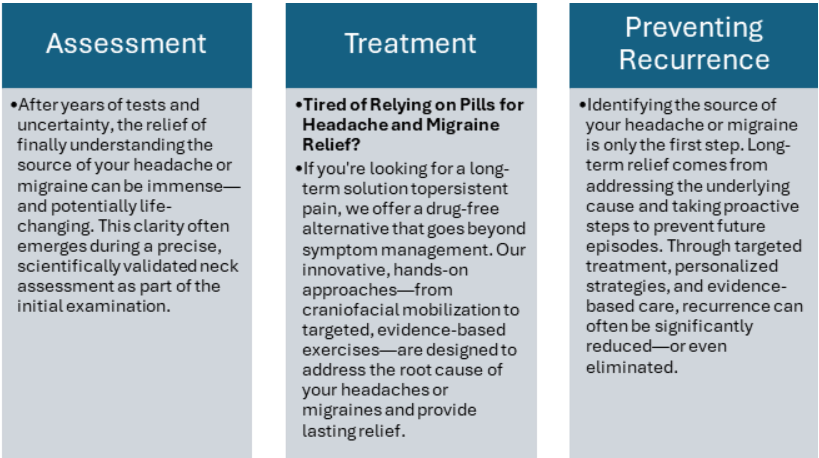Book an Appointment Today
Don’t let spine issues hold you back. Contact us today to schedule an appointment and take the first step towards a pain-free life. At asynchrony we’re here to support you on your journey to optimal spine health.

Types of Headaches
Headaches are one of the most common health complaints — but not all headaches are the same. Understanding the type of headache, you’re experiencing can help guide effective treatment. Below are the most common types:
Tension Headaches
- Description: The most common type of headache.
- Symptoms: A dull, aching sensation across the forehead or around the head; may feel like a tight band.
- Common Triggers: Stress, poor posture, fatigue, eye strain.
Migraine Headaches
- Description: Intense and often debilitating headaches.
- Symptoms: Throbbing or pulsing pain (often one-sided), nausea, sensitivity to light or sound, and visual disturbances (auras).
- Common Triggers: Hormonal changes, certain foods, sleep disruption, stress, genetics.
Cluster Headaches
- Description: Rare but extremely painful headaches that occur in cycles or “clusters.”
- Symptoms: Burning or piercing pain around or behind one eye, tearing, nasal congestion.
- Common Triggers: Alcohol, strong smells, or changes in sleep pattern (exact cause is not well understood).
Sinus Headaches
- Description: Headaches linked to sinus infections or inflammation.
- Symptoms: Pressure or pain in the forehead, cheeks, or around the eyes; often with nasal congestion or fever.
- Common Triggers: Sinus infections, allergies.
Rebound (Medication Overuse) Headaches
- Description: Headaches caused by frequent use of pain relief medication.
- Symptoms: Daily or near-daily headache that returns when medication wears off.
- Common Triggers: Overuse of medications like acetaminophen, ibuprofen, or triptans.
Cervicogenic Headaches
- Description: Headaches that originate from the neck.
- Symptoms: Pain starting in the neck and radiating to the head, usually one-sided.
- Common Triggers: Neck injuries, arthritis, or poor posture.
"Welcome to a fresh, research-based perspective on managing headaches and migraines—one that’s often overlooked, yet deeply impactful for those affected”

FAQs
A headache is pain or discomfort in the head, scalp, or neck. It can range from mild to severe and may feel pressure, throbbing, or sharp. Headaches are very common and can be caused by stress, tension, dehydration, poor posture, or underlying health conditions.
A migraine is a neurological condition that causes intense, throbbing headache, often on one side of the head. It can be accompanied by nausea, vomiting, sensitivity to light or sound, and visual disturbances known as aura. Migraines can last a few hours to several days and may affect daily life.
Symptoms include dull, sharp, or pressure-like pain in the head, tension in the neck or shoulders, fatigue, irritability, and difficulty concentrating. Some headaches may be short-lived, while others persist for hours.
Migraines typically involve severe, throbbing pain, nausea, vomiting, sensitivity to light or sound, blurred vision, and sometimes aura. Symptoms can interfere with work, sleep, and daily activities.
- Headaches: Stress, poor posture, dehydration, eye strain, sinus issues, or tension in neck muscles.
- Migraines: Triggers include hormonal changes, stress, certain foods, lack of sleep, sensory stimuli, and genetic factors. Understanding triggers is key for effective prevention and management.
Diagnosis involves medical history, symptom evaluation, and physical examination. For migraines, doctors may ask about frequency, triggers, severity, and associated symptoms. Imaging tests like MRI or CT scans may be used in rare cases to rule out other causes
Treatment depends on type and severity:
- Headaches: Lifestyle changes, stress management, posture correction, hydration, and physiotherapy for tension headaches.
- Migraines: Medication, lifestyle modification, identifying triggers, relaxation techniques, and physiotherapy for neck or shoulder tension that contributes to pain
Yes. Physiotherapy can:
- Relieve tension in the neck, shoulders, and upper back
- Improve posture and reduce muscle strain
- Provide exercises for pain relief and prevention
- Teach relaxation and stress-management techniques
Prevention strategies include:
- Maintaining good posture
- Managing stress and anxiety
- Staying hydrated and eating regular meals
- Identifying and avoiding personal triggers
- Getting regular sleep and exercise
Seek professional care if you experience:
- Severe, sudden headaches
- Frequent migraines affecting daily life
- Headaches with vision changes, weakness, numbness, or confusion
Early evaluation ensures proper diagnosis and effective management.
Request a Free Phone Consultation
Fill out the form and we will contact you.
Get In Touch In The Mean Time.
Want to Visit Our Clinic? Please Call Us
